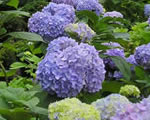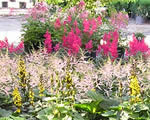
5155
NW 57th Ave
Johnston, Iowa
Click for Directions
Store
Hours
Monday
- Friday
8:00am - 5:00pm
Saturday
8:00am - 4:00pm
Learn
The Lingo of
Garden Centers
By Jeff Iles
| I have a confession
to make. When it comes to home repairs I'm not very handy. In fact,
put me in a hardware store and I panic.
How's a guy supposed to know what all that stuff is for? Just how many kinds of nails do you need, anyway? Are there really left-handed screwdrivers? Drop me off at the local garden center or nursery, though, and it's like coming home. Pallets of fertilizers, rows of plants, with difficult-to pronounce names, mountains of bagged mulch and rock, and check those new pruning saws. Is it that way for you, too? I can provide a few words and phrases that will help you converse in the same language as the nursery salesperson. Balled and burlapped: "If I load this balled-and-burlapped red maple tree into your trunk, you're going to need someone the size of Arnold Schwarzenegger to unload if for you when you get home." Balled-and-burlapped plants - trees and shrubs-begin their life at the production nursery, where they spend several years growing in the field. When plants reach saleable size, they are dug from the field so that the soil immediately around their roots remains undisturbed. The ball of earth containing the roots of the plant is held together with burlap, small nails, twine and occasionally a metal cage. Balled-and-burlapped plants usually are quite heavy. They require special equipment and careful handling. Bare-root: "I don't want to spend $200 on a shade tree. Do you have any less expensive bare-root trees?" Bare-root plants also begin their life growing in a nursery field, but when they are harvested (usually in the fall), all the soil is shaken from their roots. Because bare-root plants do not have a soil ball, they are considerably lighter, less expensive to ship and therefore cost less than balled and burlapped or container-grown plants. After harvest, bare-root plants are stored in special climate-controlled buildings until later winter whereupon they are shipped to retail nurseries and garden centers. Retailers may offer these same plants "bare-root" to their customers, or grow them in containers for sale later in the season. Because bare-root plants are vulnerable to temperature and moisture extremes, retailers prefer to sell them before they bud and produce leaves. This means the season for selling bare-root plants comes very early in the growing season, March and April. A new gravel bed technique has expanded the bare-root season for retailers and their customers. Researchers have shown bare-root plants "held" in raised beds filled with pea gravel develop tremendous root systems and are quite capable of being lifted from these beds and transplanted to the landscape in the heat of summer. Caliper: "If this tree were a gift for my fiancée, I'd go with the 3-inch-caliper tree instead of a measly 2-inch tree." In the nursery and landscape trade, caliper in the diameter of a tree, measured at a point 6 inches above the ground line if the resulting measurements is no more than 4 inches. If the resulting measurement is more than 4 inches, the measurement is made at a point 12 inches above the ground line. More important, a 3-inch caliper tree will be older, larger and more expensive than a 2-inch caliper tree. Container-grown: "If this lilac I bought from you was container-grown, then why did all of the soil fall away from the roots when I removed it from its pot?" Many trees and shrubs spend much of their young lives in the nursery growing in containers. Some "container-grown plants" are offered for sale before they have fully established themselves. A true container-grown plant will have a well-established root system that reaches the sides of the container so that when the container is removed, the soil and root system do not separate from one another. Hardiness: "The tag on this flowering dogwood says it's hardy to zone 5. Does this mean I can grow it in Mason City?" The terms hardy or hardiness refer to the U.S. Department of Agriculture Plant Hardiness Zone Map. The map divides the country into eleven zones and provides an estimate of the average annual minimum temperature in each zone. Landscape plants "hardy" to a zone will have the capability of withstanding the minimum winter temperatures typical in that zone. In our example, expected minimum temperature in zone 5 range from 10 to 20 below zero. Mason City is in zone 4, 20 to 30 below zero, so the chances of flowering dogwood surviving a winter in northern Iowa are pretty slim. Heeled-in: "I hope you don't mind walking, because the balled and burlapped shade trees are heeled-in at the back of the nursery." The technique of heeling-in is the oldest and simplest method of plant storage. Plants, frequently balled and burlapped trees and shrubs, are placed upright on a section of well-drained ground and their rootballs are covered with a loose, damp medium such as year-old shredded bark or wood chips. These heeling-in materials insulate rootballs from injurious high and low temperatures and keep them from drying. Trickle irrigation: "I just tripped over one of your tickle irrigation lines back in the balled and burlapped shade trees and I think I broke my ankle." Overhead irrigation can be an inefficient and wasteful way of applying water to trees and shrubs in the nursery. Alternatively, trickle irrigation systems apply water at low pressure directly over a plant's root system. Water is delivered to each plant via a microtube (a small plastic tube) attached to a main line. Unfortunately, these small microtubes are difficult to see and can trip the unsuspecting client or rookie employee. That's it. Armed with this vocabulary, you should be able to confidently stride into any garden center in Iowa and command immediate respect from the paid staff. But be careful. If you sound too professional, you might be mistaken for an employee. Jeff Iles is a horticulturalist
with Iowa State |
© Miller Nursery Inc. 2008


